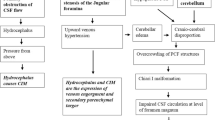Abstract
Introduction
The ciliopathy “Joubert syndrome” was first described in 1969 by Dr. Marie Joubert and most subtypes follow an autosomal recessive inheritance. The complex disorder shows typical clinical features, such as hyperventilation, abnormal eye movements, and retardation. A pathognomonic midbrain-hindbrain malformation, the molar tooth sign, can be found on magnetic resonance imaging of the brainstem. There are a little more than 200 reports of Joubert syndrome in the literature.
Case presentation
We report a case of a 9-year-old boy who developed a progressive hydrocephalus starting from the age of 4. He underwent VP shunt placement at 8 years, which relieved hydrocephalus-related clinical symptoms and put development of the macrocephalus to a halt.
Conclusion
Neonatal hydrocephalus due to the altered anatomy of the posterior fossa has been reported earlier, but to our knowledge, this is the first case of a delayed onset of hydrocephalus in a patient with Joubert syndrome.

Similar content being viewed by others
References
Brancati F, Dallapiccola B, Valente EM (2010) Joubert syndrome and related disorders. Orphanet J Rare Dis 5:20
Joubert M, Eisenring JJ, Andermann F (1968) Familial dysgenesis of the vermis: a syndrome of hyperventilation, abnormal eye movements and retardation. Neurology 18:302–303
Zaki MS, Abdel-Aleem A, Abdel-Salam G, Marsh SE, Silhavy JL, Barkovich AJ, Ross ME, Saleem SN, Dobyns WB, Gleeson JG (2008) The molar tooth sign: a new Joubert syndrome and related cerebellar disorders classification system tested in Egyptian families. Neurology 70:556–565
Rehman I, Bett Z, Husen Y, Akhtar AS, Khan FA (2009) The ‘molar tooth sign’ in Joubert syndrome. JPMA. J Pak Med Assoc 59:851–853
Valente EM, Dallapiccola B, Bertini E (2013) Joubert syndrome and related disorders. Handb Clin Neurol 113:1879–1888
Abdelhamed ZA, Wheway G, Szymanska K, Natarajan S, Toomes C, Inglehearn C, Johnson CA (2013) Variable expressivity of ciliopathy neurological phenotypes that encompass Meckel-Gruber syndrome and Joubert syndrome is caused by complex de-regulated ciliogenesis, Shh and Wnt signalling defects. Hum Mol Genet 22:1358–1372
Parisi M, Glass I (1993) Joubert syndrome. In: Adam MP, Ardinger HH, Pagon RA, Wallace SE, LJH B, Stephens K, Amemiya A (eds) . GeneReviews((R)), Seattle (WA)
Genel F, Atlihan F, Ozdemir D, Targan S (2004) Development of hydrocephalus in a patient with Joubert syndrome. J Postgrad Med 50:153
Author information
Authors and Affiliations
Corresponding author
Ethics declarations
Conflict of interest
On behalf of all authors, the corresponding author states that there is no conflict of interest.
Rights and permissions
About this article
Cite this article
Fehrenbach, M.K., Nestler, U., Meixensberger, J. et al. Late-onset hydrocephalus in a child with Joubert syndrome: a case report. Childs Nerv Syst 34, 1423–1425 (2018). https://doi.org/10.1007/s00381-018-3767-0
Received:
Accepted:
Published:
Issue Date:
DOI: https://doi.org/10.1007/s00381-018-3767-0



